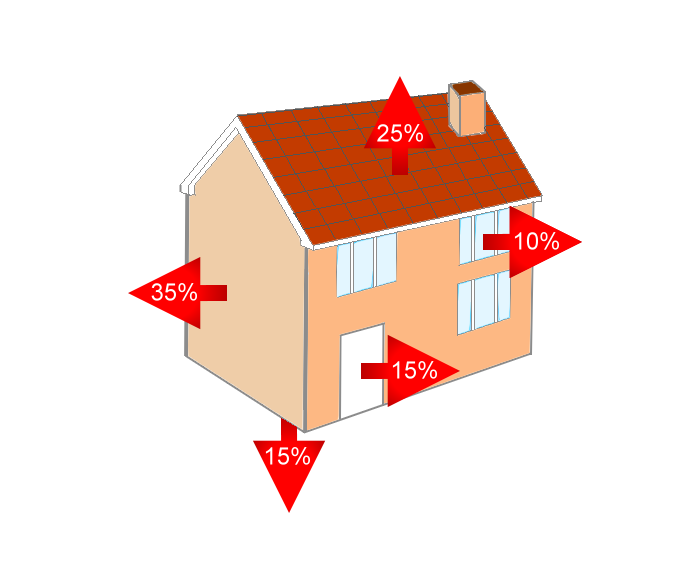Insulation makes perfect sense for anyone looking to create a greener, more energy efficient building, and it should be your first step on the road to a low carbon home. After all, there is little point in spending money to generate renewable heat in your home if a large amount of it is being lost to the outside environment. Read on and see for yourself how much you do or don’t know about the wonderful world of insulation.
How does insulation work?
If your loft is insulated with the recommended 270mm of mineral wool, you know that it’s doing a great job of reducing heat loss through the roof, but how does it work? If you thought it was the insulation material itself, you’d be wrong. This physical insulation of a home is actually done by the spaces in between the insulating material; by the trapped pockets of air.
Air is a very poor conductor of heat, and when it is trapped in pockets by the insulating material, convection cannot occur. This means that the air remains the same temperature, no matter what the temperatures on either side of the insulation barrier are doing, helping to regulate heat losses and gains from both sides.
 Rice University / CC BY 3.0
Rice University / CC BY 3.0
Materials such as Rockwool and fibreglass mimic natural insulation that we might see in a bird or mammal. They trap air in pockets which are too small to allow for convection, thereby using the air itself as insulation.
What is insulation for?
If you thought insulation was for stopping heat loss, you’d only be half right. Of course this is an important function of insulation, and the reason most people will have it installed. However, it also plays an important role in stopping heat gain, so your home will stay warm in winter and cool in summer.
What is insulation made from?
There are a number of materials in use as insulation. Some of the most common include:
- Fibreglass: One of the most popular materials for insulating homes, fibreglass can come in a blanket roll which can be laid down in lofts or pinned into walls. It can also come as a loose fill insulation which can be blown into cavities and small spaces. It is an irritant, so although you can install it yourself you should wear protective clothing and a mask. It is non-combustible and doesn’t retain water, making it an ideal long term insulation product for many applications.
- Mineral wool / Rockwool: Mineral wool is very similar to fibreglass in its appearance and texture, but has the added advantage of being made up of around 75% recycled content. It can be supplied as a blanket or as a blown loose fill material and is suitable for a wide range of applications.
- Sheep’s wool: Of all the blanket insulation materials available, sheep’s wool is the most eco-friendly. As a natural material, there is very little embedded carbon in the production and distribution of sheep’s wool. Added to this, when the house eventually gets demolished, as all houses will ultimately, the wool will simply decompose and return to the ground. Fibreglass, on the other hand, will be around for a lot longer than your home is.
- Newspaper: Yes, the common newspaper can be recycled into very useful and effective insulation for lofts. It comes in loose fill form and is blown into the loft. However, in some cases a chemical will need to be applied to make it fire resistant, and it can be susceptible to damp and to being blown around in draughty lofts.
- Insulation boards: Insulation boards are a great solution for awkward areas as they can be nailed up, glued and cut to shape for a wide variety of purposes. They can be made from a whole range of materials, from polystyrene and foam to greener options like cork, wood and straw.
- Spray foam: This insulation material requires a professional to install and can be costly, but is also a great way of quickly insulating a large area in a permanent and efficient manner. Entire lofts can be spray coated with one of these plastic based foams, or it can be used to insulate in small gaps, awkward spots or to help with draught proofing.
- Poly beads: Lots of cavity wall insulation installers now opt for the poly bead method. These little polystyrene beads are easy to blow in through small access holes in the exterior wall, and tend not to sink over time as much as mineral wool does. For additional insulation some installers offer an upgrade to carbon poly beads, which are simply the same beads but with a carbon coating, claimed to offer a lower R value.
As well as these typical insulation materials there are many other products that can help with reducing heat loss in your home. Things like foil and reflective panels can be used to insulate blinds or to reflect heat away from outside walls, and simple stocking snakes or silicon sealant can do wonders for your draught proofing.
Where should insulation be applied?
Understanding where heat is lost from a house is the best way to prioritise your insulation investments. For most homes, the priority will be the walls, then the roof, followed by the floors and draught proofing. However you need to consider the type of home you live in too. Mid terraced homes do not have as much external wall area as detached properties, and bungalows usually have much large loft spaces than double storey homes.



